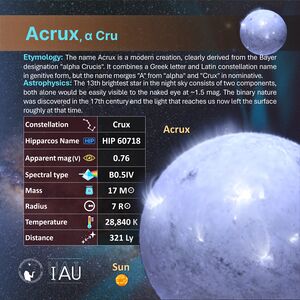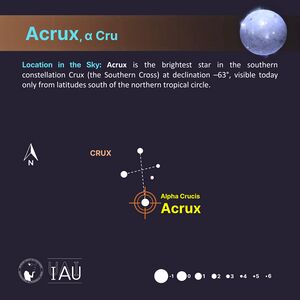Acrux
Acrux is a modern star name adopted by the International Astronomical Union in the IAU-Catalog of Star Names (IAU-CSN). Its origin is Contemporary. It is the name of HIP 60718 (α Cru, HR 4730) in constellation Cru.
Etymology and History
The name "Acrux" for α Crucis is a modern creation.[1] It is derived from the Bayer designation "Alpha Crucis" that combines a Greek letter and the Latin constellation name in genitive form (although the Greek designation was applied by Lacaille in 1756, not Bayer himself). The star name combines "A" from "alpha" and the Latin constellation name "Crux" in nominative.
Visible today only from latitudes south of the northern tropical circle, it has been visible in the Mediterranean in the past few millennia. Historically, due to precession, it was observed by ancient Hindi, Roman and Greek astronomers, and even in English Stonehenge three millennia before the erection of the giant stones.
Mythology
IAU Working Group on Star Names
The name was adopted by the IAU WGSN on 2016/07/20.
The 13th brightest star in the night sky at magnitude 0.8, Acrux consists of two components of 1.3 and 1.8, either of which would be easily visible to the naked eye on its own. The binary nature was discovered in the 17th century and the light that reaches us now left the surface roughly at that time.
Weblinks
- Website of the IAU WGSN: https://exopla.net/
Reference
- References (general)
- MacKworth, P.H. et al. (1938) ‘The Air Almanac: Discussion on the New Form of Nautical Allowance for Rapid Position Finding’, The Geographical journal, 92(2), p.137.
- ↑ MacKworth, P.H. et al. (1938) ‘The Air Almanac: Discussion on the New Form of Nautical Allowance for Rapid Position Finding’, The Geographical journal, 92(2), p.137.






